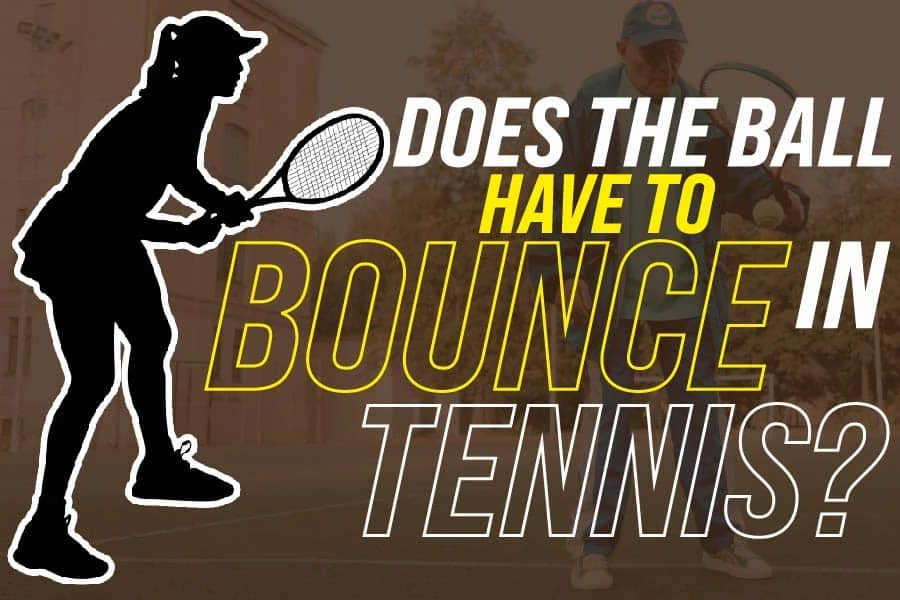Tennis is a fun sport that people of all ages can enjoy. People worldwide play tennis, either professionally or for recreational purposes. It is a game that anyone can play, regardless of their age or fitness level.
One of the first things everyone wonders when they first start playing tennis: does the ball have to bounce in tennis? This is one of the many arguments about the rules of tennis. This article will help you learn more about the bounces in tennis.
Does the ball have to bounce in tennis?
No, a tennis ball does not have to bounce on your side of the court before you hit it. Hitting the ball right away is called a volley, while striking it after bouncing is called a slice or groundstroke.
If you are close to the net at the correct time, you ought to be able to get the point in no time. Professional players choose to volley the ball more often on certain surfaces, such as fast hard courts or grass. They are very well aware of the significant advantage that such a court provides.
The distance between you and your opponent is half when you are at the net. Consequently, your opponent has twice as much time to swing back and propel the racket toward the ball. There are few expert players, much fewer tennis beginners, who can pull out consecutive volleys successfully.
Players have different swings and techniques for playing with or against backspin balls that do not necessarily require the ball to bounce first. Some professional tennis players can hit a ball without letting it bounce on their side of the net.
This is done by hitting the top of the ball to travel downwards and make contact with the ground while still in the air. Players who can do this are said to have a good ‘touch.’
Touch is the main factor in playing with underspin balls. If you hit these types of shots correctly, the ball will travel downwards and bounce on your opponent’s side of the court rather than yours, which makes it difficult for them to return this shot.
Rules For Returning A Serve In Tennis
Tennis, like many other sports, has rules that one must follow. These rules are important because they ensure fairness and safety for all players on the court.
In tennis, there is a specific set of guidelines to follow when returning an opponent’s serve (a server serves the ball from behind the baseline over the net, bouncing once before the opponent returns it). The rules are as follows:
- The player must hit the ball into play before it bounces twice.
- The player on which side of the court where the serve is being executed has an advantage. It is because he/she can return a shot more quickly than his/her counterpart who’s on the other side of the net.
- If the ball is not hit into play, a fault has occurred, and the other player gets the point.
- The server can only serve two consecutive faults before losing the point.
These are some of the basic rules that must be followed when returning a serve in tennis. Knowing these guidelines will give you an advantage on the court when facing an opponent.
Can The Ball Bounce Multiple Times Before Returning A Hit In Tennis?
Some professional tournaments, like Wimbledon, have a rule that the ball can only bounce once before it is returned. This rule was put into place to make the game more challenging and exciting for spectators. Recreational players typically don’t need to worry about this rule since they are playing on courts with lower play standards.
For non-professional games, the tennis ball can bounce off the court surface multiple times before returning a hit, but the number of bounces is not unlimited. The first time the ball hits the ground, it must rebound into play.
After that, it can hit the ground repeatedly before being returned. This is as long as it doesn’t go out of bounds or touch a player or their clothing.
Why Do Tennis Players Bounce The Ball Before Serving?
When you watch a tennis match, you’ll notice that the players always bounce the ball before serving. But why do they do this?
Bouncing the ball also allows players to check its condition. By feeling the ball’s bounce, they can tell if it’s wet or has any other problems that could affect its performance.
This is especially important when playing in hot weather, as a wet ball will travel more slowly and easily be missed by the opponent. A ball in good condition will also bounce at a consistent height, allowing the server to perfect their toss.
Bouncing the ball also gives players a chance to plan their next move. Tennis games are often won or lost on the first shot, so it’s important to be ready when that moment comes.
Before serving, players need time to get into position and prepare themselves for the shot. The bounce allows them this time without wasting any of their little 25-second break between points. This is especially useful if you have just come back from a long rally, as you’ll need to rest and get your breath back before serving.
By bouncing and then studying the bounce, they can understand how the other player is likely to return the ball. This information can help them choose the right serve or shot to hit back. It can also help them determine whether they should continue to play defensively or go on the offensive.
Finally, bouncing the ball before serving helps players time their serves. The ball must stay in contact with the ground for a short time before it’s allowed to go into play, and bouncing balls make sure that this rule is followed.
How Many Times Can You Bounce A Ball Before The Next Serve?
This is a question that people can ask about any sport, but it is most commonly asked regarding tennis. The answer depends on the type of ball being used and the surface it bounces on.
For example, a ball can bounce up to eight times before the next serve on a hard court.
However, on a clay court, the ball may only bounce four times before the next serve. The type of ball being also used matters. A harder ball will bounce more times than a softer ball.
Although there is no official limit to how many times a tennis player can bounce the ball before serving, many players bounce the ball about 4 to 8 times.
Tips For Better Tennis Play
- Practice good movement patterns. Use cones or other markers on the court to practice sprinting, zigzagging and cutting in various directions. Then incorporate tennis shots into these movements so you can work on accuracy and speed, and agility.
- Hit the ball with pace. When you hit the ball, try to accelerate through the shot. This will add power and help keep your opponent on their toes.
- Use your body to create angles. By positioning yourself in different areas of the court, you can take advantage of your opponent’s weaknesses and make it more difficult for them to return your shots.
- Mix up your shots. Don’t always hit the ball in the same spot; vary your strokes and use your forehand and backhand. It will keep your opponent guessing and make it more difficult for them to defend against your attacks.
- Stay calm under pressure. When the game is on the line, staying cool and making good decisions are important. Don’t do too much; focus on your strengths and let your opponent make mistakes.
- Get in a good position to return serve. When you’re returning serve, it’s important to be in a balanced position with your knees slightly bent and back straight. This will allow you to move quickly in any direction, should the ball come at you off-center or out of reach.
- Watch what your opponent is doing to get an idea of their playing style, strengths and weaknesses. Use this information to plan your shots and put them under pressure.
- Stay hydrated and well-rested. To play your best, it’s important to take care of your body both on and off the court. Drink plenty of water, eat a healthy diet and get plenty of rest. It will help you stay strong and energetic throughout your match.
Conclusion
Does the ball have to bounce in tennis? Yes, it does. The tennis ball bounces off the ground and returns to the opponent, giving them less time to react. For this reason, you should always keep your eyes on where the ball will land after it hits the ground because it could be coming right back at you.
Tennis players need to bounce their balls before serving, so they don’t miss out on an easy point by not reacting in time. Tennis players bounce the ball before serving because they want to be sure that it will land on their opponents’ side of the court. It is also done for practice and timing purposes and to check the ball’s condition.







